Did you know that employees spend almost 1.8 hours every day—9.3 hours per week, on average, searching and gathering information?
A document creator addresses this inefficiency by providing diverse document templates, easy-to-use interfaces, and integration capabilities to effortlessly create, manage, and distribute documents.
I have seen firsthand how these tools speed up the document creation process and ensure consistency across all documentation, essential for maintaining brand integrity and compliance standards.
In this blog, we will explore how these document-creator platforms can help transform your business operations. Let’s discuss my top 10 best document creation software for 2025, starting with a quick look at my top three.
| Best Document Creator | Best For | Pricing |
| ProProfs Knowledge Base | Easily creating technical documents, manuals, help sites, and private knowledge bases | Forever Free plan with all the premium features for up to 25 articles. Paid plan starts at $49/author/month |
| Confluence | Team collaboration on collaboration | A free plan is available. Paid plan starts at $60.05/10 users/month |
| Nuclino | Fast Collaboration to Bring Knowledge, Docs & Projects | A free plan is available for up to 50 items. Paid plan starts at $5/user/month |
Now, before jumping to the list, let’s discuss some basics.
What Is Document Creator Software?
Document creation software is an application designed to assist in creating, formatting, and publishing various types of digital documents. This software streamlines the document creation process, making it easier for users to produce professional-looking reports, presentations, newsletters, and more without requiring extensive design or technical skills.
These tools often include various features, such as knowledge base templates, text formatting options, adding images and multimedia, and collaboration capabilities, allowing multiple users to edit and manage documents simultaneously.
For example, Microsoft Word provides a comprehensive set of writing tools and a wide array of templates for everything from simple letters to complex reports. Users can add tables, charts, images, and custom formatting to enhance the appearance and effectiveness of their documents.
Also, with integrated cloud support, documents can be stored online and accessed from anywhere, facilitating easy sharing and collaboration among team members. This kind of software exemplifies how document creation tools help streamline workflows, enhance productivity, and enable users to communicate their ideas more effectively.
Which Is the Best Document Creator in 2025?
Document creation software simplifies designing and distributing diverse documents. When choosing your ideal one, look for tools that offer robust editing features, compatibility with existing workflows, and collaboration features.
Here are my top three recommendations:
Option #1 – ProProfs Knowledge Base
ProProfs Knowledge Base, with its AI-enabled text editor and pre-approved templates, helps create error-free documents efficiently (public, private, embedded inside your app/software, or integrated with chat). Its collaborative features, like internal comments, smart user management, custom workflows, and more, make document collaboration efficient.
Option #2 – Confluence
Confluence allows teams to build, organize, and collaborate on documents within a centralized platform. It is especially powerful for creating detailed project documentation, meeting notes, and product requirements with rich formatting options and templates. It is also integrated with Jira to enhance project tracking.
Option #3 – Nuclino
Nuclino allows users to create and connect documents effortlessly. Its platform supports real-time editing, which is ideal for meeting notes, project plans, and brainstorming sessions. Its visual representation of documents as a graph helps understand the structure and connections between different pieces of content, promoting an efficient way to navigate and organize information.
Top 10 Best Document Creator Software & Tools in 2025
Choosing the right document creator is crucial as it significantly enhances productivity and ensures consistency across all organizational documentation.
Let’s look at 10 such tools that enable automated document generation.
1. ProProfs Knowledge Base – Best for Easily Creating Technical Documents, Help Sites, Manuals & Private Knowledge Bases
Our team has been using ProProfs Knowledge Base since 2020 to create comprehensive technical documents with its simple, Word-like text editor. We can use a variety of heading tags, insert images, embed YouTube videos, and interlink with other help pages.
With its collaboration capabilities, we can effortlessly provide feedback, discuss with teammates, and enhance content quality. We can also display or hide articles with conditional content when specific rules are met. We can assign different roles to different users, which can help ensure that the information within the portal stays accurate and reliable.
We can get detailed reports to get a bird’ s-eye view of your knowledge base activity, including the total searches, failed searches, articles created, total reads, etc. With this data, we can identify popular and poorly rated articles, failed keywords, new articles created, and more.
What you will like:
- 100+ knowledge base templates to help you get started quickly
- Revision history to track up to 30 recent changes made to your knowledge base, restore previous versions, and compare two different versions of a page or article
- Multi-branding to create different versions of a single site by applying different branding styles to it
- Control the layout, format, and presentation of your knowledge base with the help of CSS
- Authenticate and protect identities with Enterprise SSO (Single Sign-On) using IDP services like Okta and Azure AD
What you may not like:
- The freemium plan is only limited to 25 articles
- Lacks an on-premise version
Pricing:
Forever Free plan with all the premium features for up to 25 articles. Paid plan starts at $49/author/month.
2. Confluence – Best for Team Collaboration on Documents
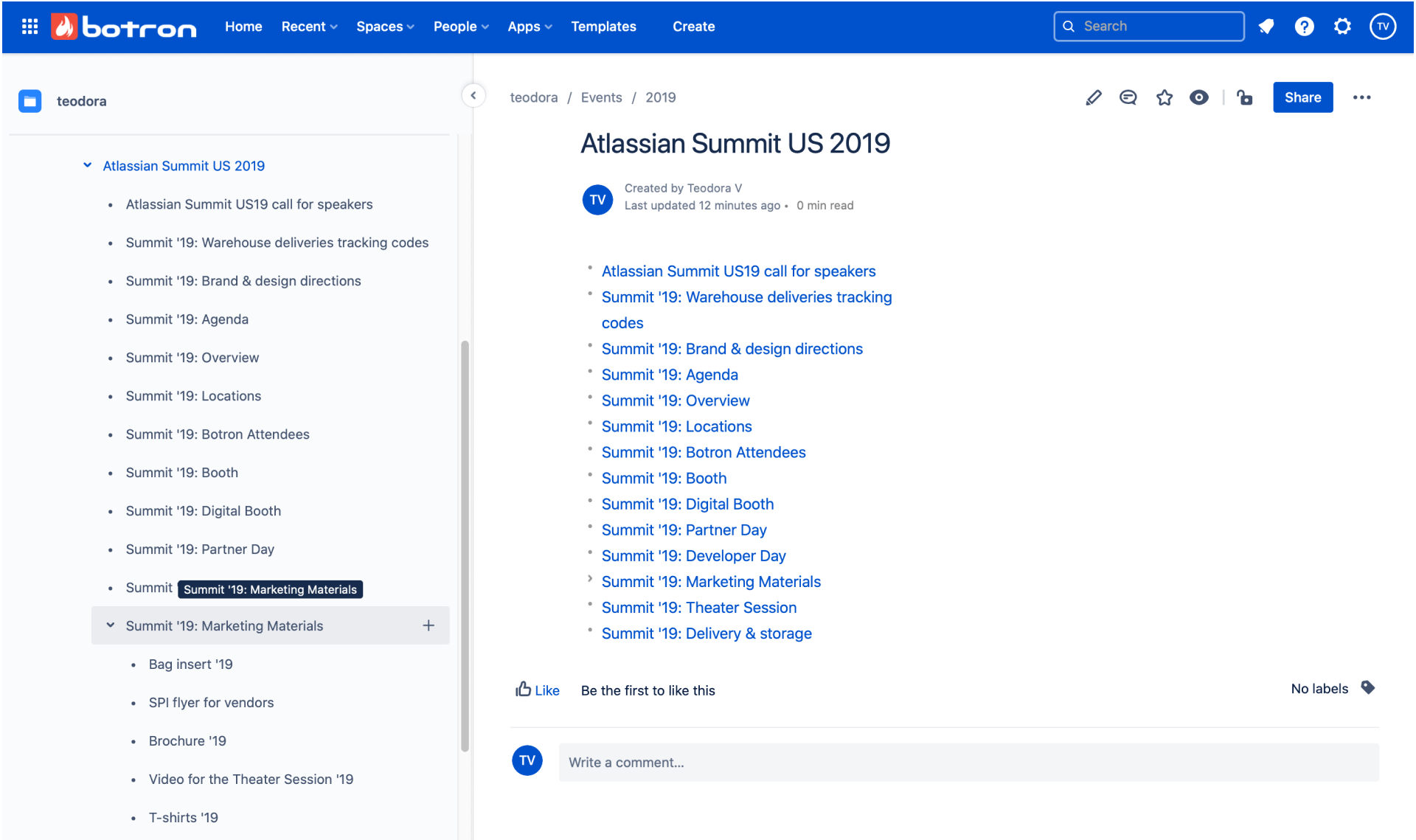
Confluence’s rich text editor is powerful and easy to use. It supports a wide array of formatting options, allowing users to craft documents that are not only informative but also visually appealing. You can insert tables, macros, images, and even code snippets, which makes Confluence ideal for a wide range of use cases, from technical documentation to business presentations.
I love its template library, which further aids in document creation by providing users with a starting point for various document types. Whether creating meeting notes, product requirements, or project reports, users can quickly get started with templates that are designed for specific purposes.
What you will like:
- Offers real-time editing and commenting capabilities
- Integrates seamlessly with other tools in the Atlassian suite, such as Jira
- Advanced search functionalities, page indexing, and tagging systems make navigating through large volumes of content straightforward and efficient.
What you may not like:
- The extensive feature set could be overwhelming for new users
- The transition could be less seamless for non-Atlassian ecosystem users.
Pricing:
A free plan is available. Paid plan starts at $60.05/10 users/month.
3. Nuclino – Best for Fast Collaboration to Bring Knowledge, Docs & Projects Together in One Place
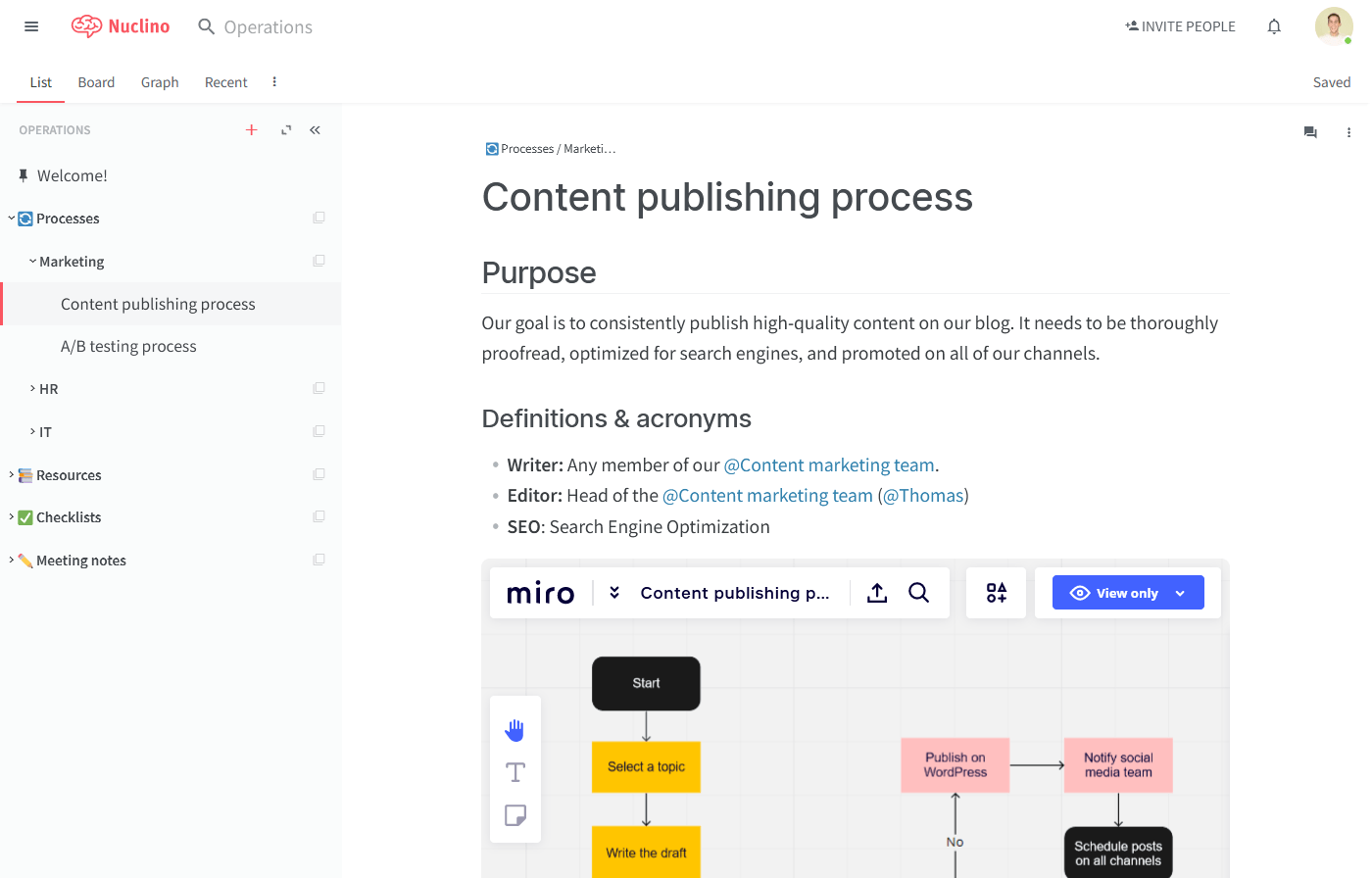
My favorite is Nuclino’s unified workspace, which allows users to create, organize, and share documents quickly. It operates on a real-time collaboration model similar to Google Docs, allowing multiple team members to edit documents simultaneously without lag.
It allows teams to structure their documents and information visually and intuitively using boards, lists, and graphs. These views can be customized to match the team’s workflow, providing a flexible approach to content management. The graph view visually maps all the documents and shows how they are interlinked, which is helpful in understanding the relationships between different pieces of information and navigating complex projects.
What you will like:
- Minimalist and clean interface
- Markdown formatting, enabling users to write and format documents with keyboard shortcuts and simple syntax quickly
- Powerful search functionality that makes finding specific documents effortless, even within large volumes of content
What you may not like:
- The lack of an offline mode can be a problem for users needing to access documentation on an unstable internet connection
- I felt that the customization options for the interface and workspace were too limited
Pricing:
A free plan is available. Paid plan starts at $5/user/month.
4. Read the Docs – Best for Open Source Documentation
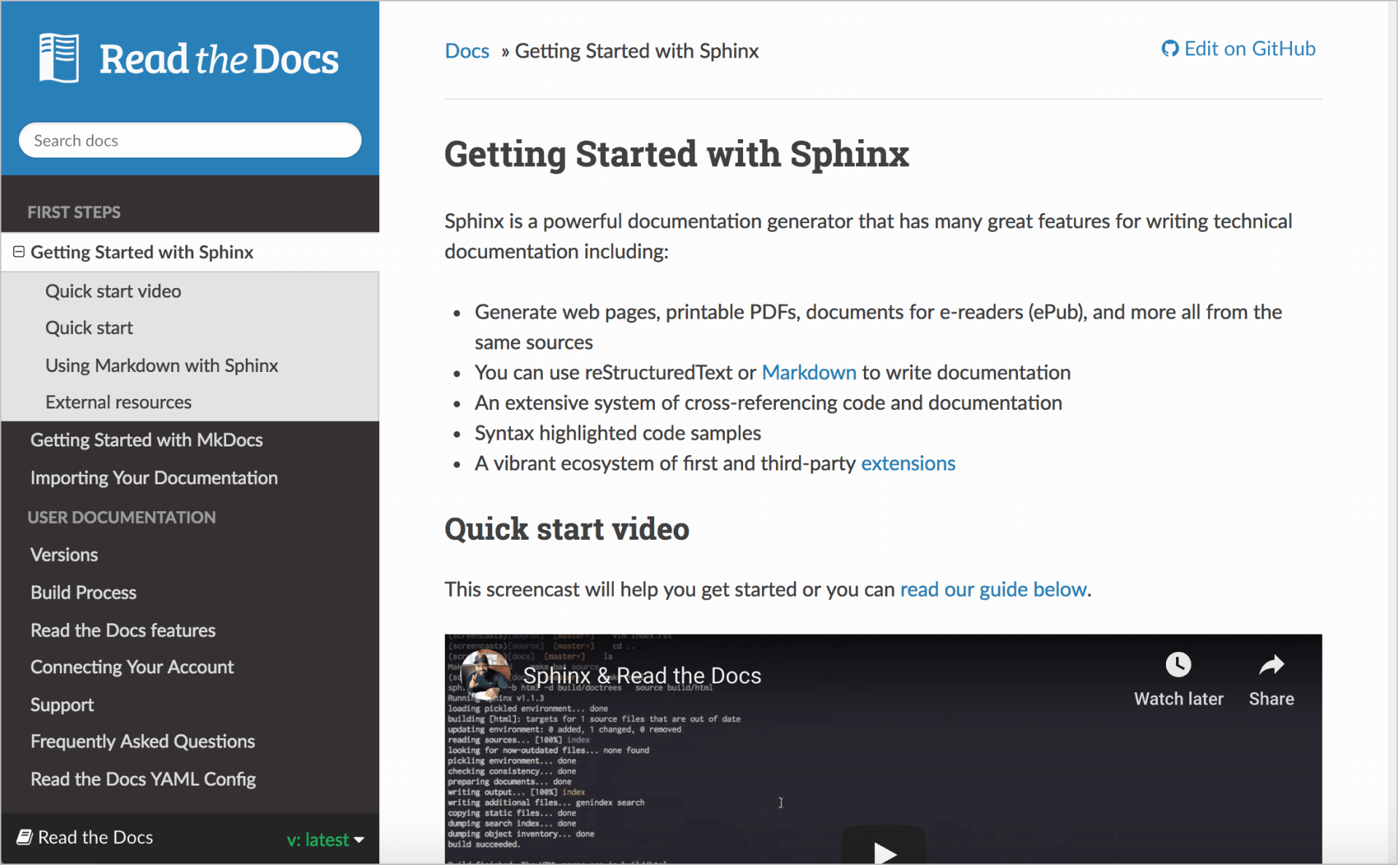
Read the Docs specializes in technical documentation for software projects. It is particularly favored by the open-source community and is designed to simplify creating, maintaining, and hosting documentation. With its robust features and seamless integration with code repositories, Read the Docs is ideal for developers looking to automate documentation alongside their code development processes.
The platform’s standout feature is its automatic documentation generation. When connected to a version control system like GitHub, Bitbucket, or GitLab, Read the Docs automatically builds and updates documentation every time changes are committed to the repository. This automation ensures that the documentation remains up-to-date with the latest software version.
What you will like:
- Supports Sphinx and MkDocs, powerful tools that are used to write documentation using plain text
- Supports a variety of output formats including HTML, ePub, and PDF, among others.
- Allows users to maintain multiple versions of the documentation in parallel
What you may not like:
- Limited customization options for the documentation theme and layout
- Lacks a WYSIWYG editor, requiring knowledge of reStructuredText or Markdown
Pricing:
Paid plan starts at $50/month.
5. Doxygen – Best for Generating Documentation from Code
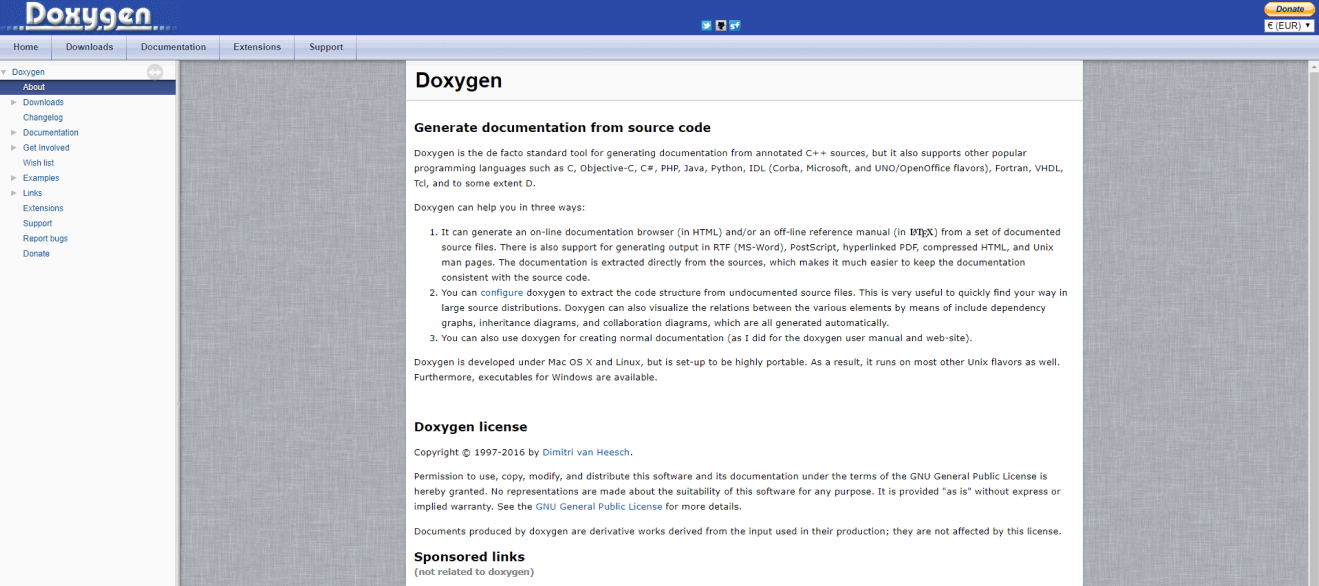
Doxygen is used in software development to create online documentation from annotated source code. It supports various programming languages, including C++, C, Java, Objective-C, Python, and more. Parsing the source code and extracting comments generates comprehensive and well-structured documentation, which can be output in multiple formats such as HTML, LaTeX, RTF, and XML.
I found its integration with Graphviz handy. With this, it can create graphical representations of class hierarchies, collaboration diagrams, and call graphs. These visual aids are invaluable for understanding complex codebases, providing a clear view of the relationships and interactions between different components.
What you will like:
- Can generate inheritance diagrams, which help developers quickly grasp the structure of object-oriented code
- Support for customizable documentation – developers can use special commands within comments to add detailed descriptions, parameters, return values, and other relevant information
- Supports a range of documentation styles, making it adaptable to different coding standards and preferences
What you may not like:
- Primarily designed for technical users, it could be complicated for non-technical staff
- Unlike its competitors, it lacks real-time collaboration features
Pricing:
Doxygen is a free, open-source platform.
6. Bit.ai – Best for Rich Media Integration Within the Documentation
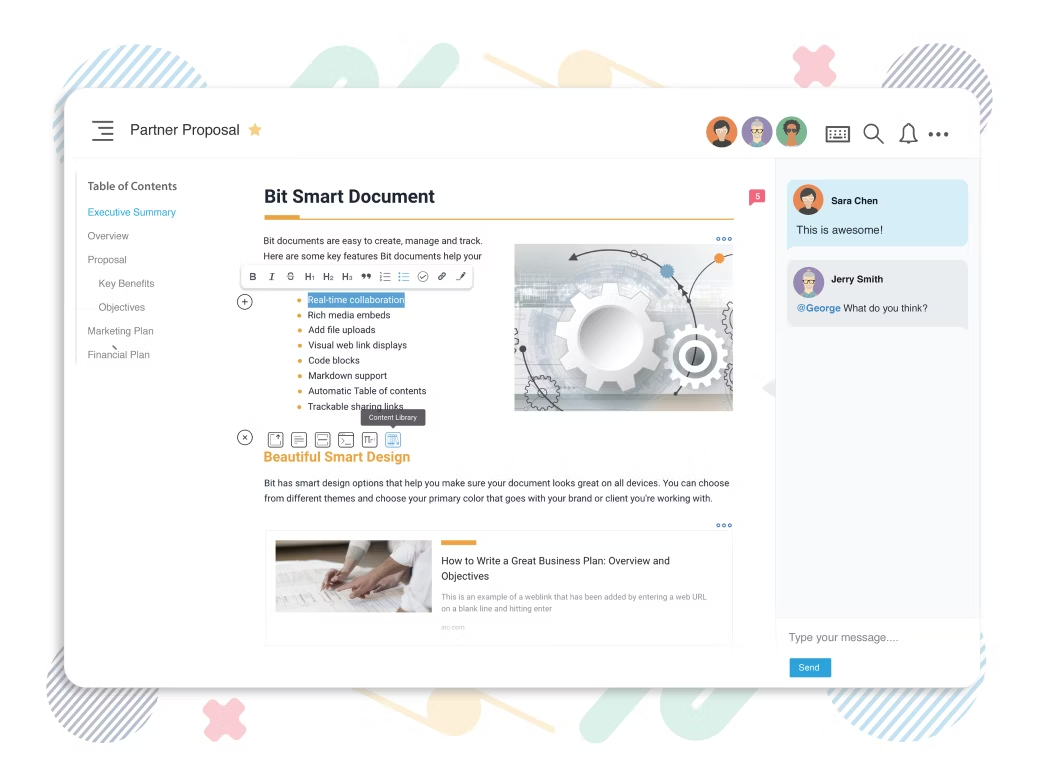
Bit.ai supports a wide range of content types, including text, images, videos, and links, allowing users to create rich, interactive documents beyond simple text files. Its real-time collaboration capabilities enable in-line comments and mentions, facilitating direct and context-specific communication within documents.
I like how it allows users to embed content from multiple platforms, including Google Drive, YouTube, Trello, and GitHub, into their documents. This integration capability makes Bit.ai a central hub for all project-related information, ensuring that all relevant resources are easily accessible and organized in one place.
What you will like:
- Ability to set granular permissions for each document, controlling who can view, edit, or comment on the content
- Robust data encryption and compliance with industry standards, offering peace of mind that organizational data is secure
- Powerful analytics feature provides insights into how documents are being used and interacted with
What you may not like:
- Some users have requested more formatting and design options to align documents closer with organizational branding
- Some userasked for furtheritional font types to provide more document customization options.
Pricing:
A free plan is available. Paid plan starts at $12/member/month.
7. Document360 – Best for Creating Online Documentation
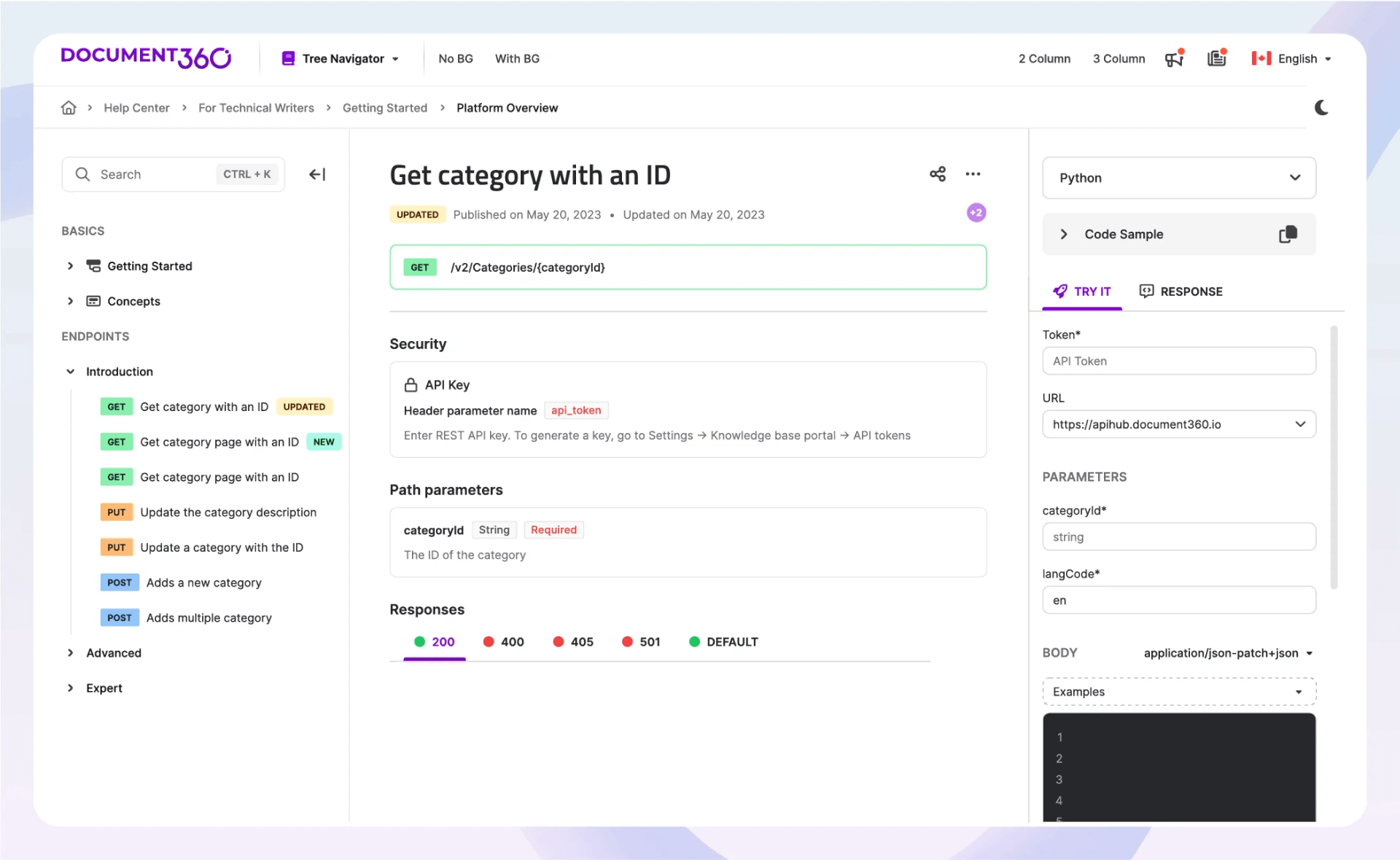
I have used Document360 in the past for its robust platform for creating detailed, organized, and accessible documentation. Its powerful editor supports both Markdown and WYSIWYG (What You See Is What You Get) modes. This allows users to choose their preferred content creation method, catering to technical and non-technical users.
Its category manager provides a hierarchical structure for organizing content, allowing users to create nested categories and subcategories. This makes building a well-structured knowledge base easy. The intuitive drag-and-drop interface simplifies rearranging articles and categories, ensuring that the knowledge base remains logically organized and easy to navigate for users.
What you will like:
- The editor supports rich media content, enabling the inclusion of images, videos, and links to create engaging and comprehensive documentation
- Offers detailed version histories, allowing users to revert to previous versions if necessary
- The commenting and review system facilitates team communication and feedback, ensuring all contributions are captured and considered.
What you may not like:
- Users have requested more control over design elements like image placement and article layouts
- New users may find the interface and certain features overwhelming without sufficient onboarding
Pricing:
A free plan is available. Paid plan starts at $149/project/month.
8. GitBook – Best for Creating Smart Technical Documentation
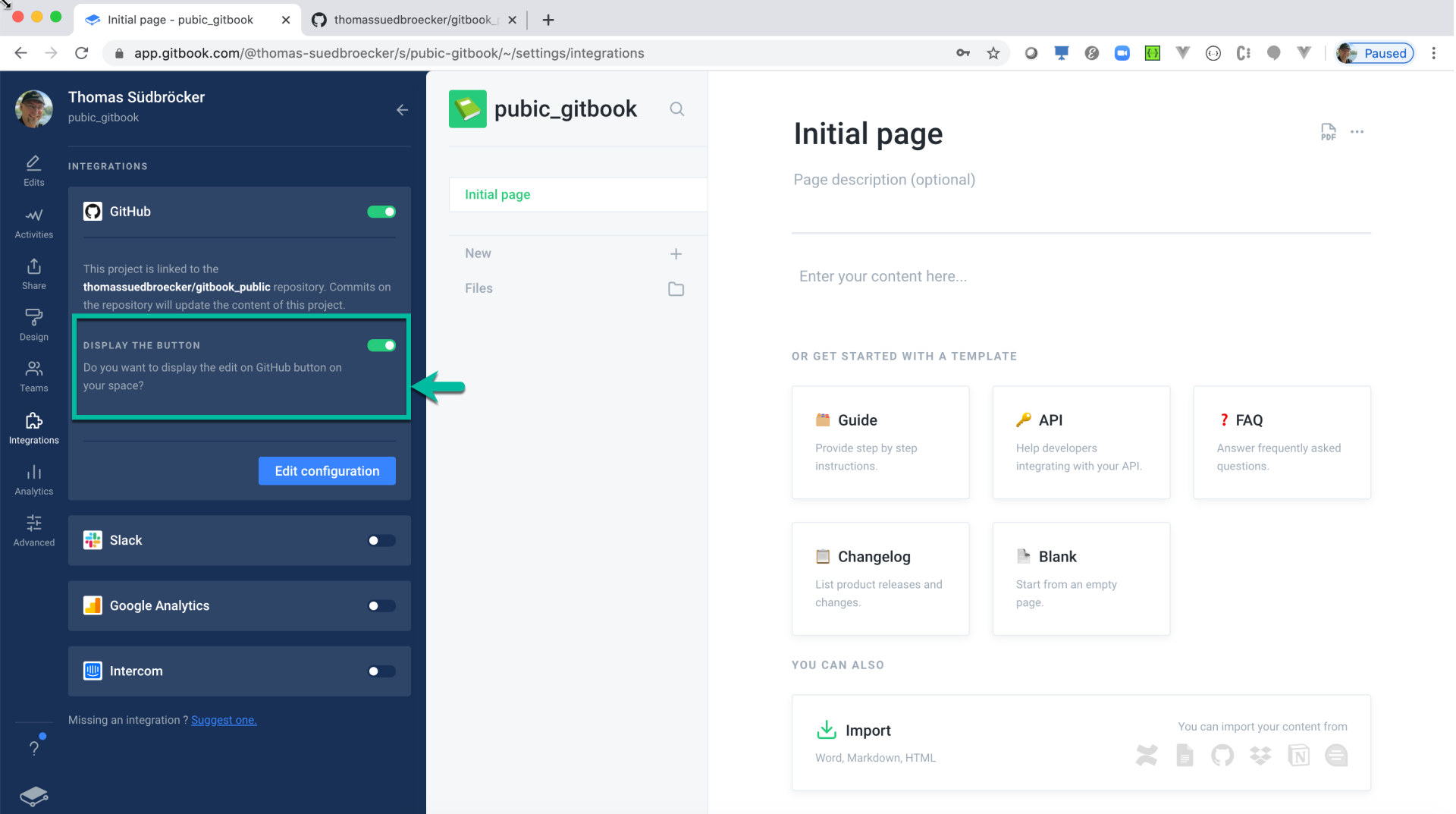
Initially created to document open-source projects, GitBook has evolved into a comprehensive platform that supports various documentation needs, from technical manuals and user guides to internal knowledge bases and company handbooks.
It offers a clean, intuitive interface that supports Markdown and rich text editing, allowing users to choose their preferred content creation mode.
The platform’s real-time collaboration functionality enables multiple team members to work on the same document simultaneously, with changes visible to all collaborators as they happen. GitBook’s version control enhances this seamless collaboration, tracking changes and allowing users to revert to previous versions if needed.
What you will like:
- Allows users to create a nested structure of chapters and sub-chapters, making it easy to organize large volumes of information logically
- Can sync with Git repositories, making it easy to keep documentation in sync with code changes
- Helps customize the appearance of their documentation to align with their brand’s identity
What you may not like:
- Lack of offline access
- Sometimes, the editor can be glitchy, causing formatting issues
Pricing:
A free plan is available. Paid plan starts at $6.70/user/month.
9. PandaDoc – Best for Handling High Volumes of Documents
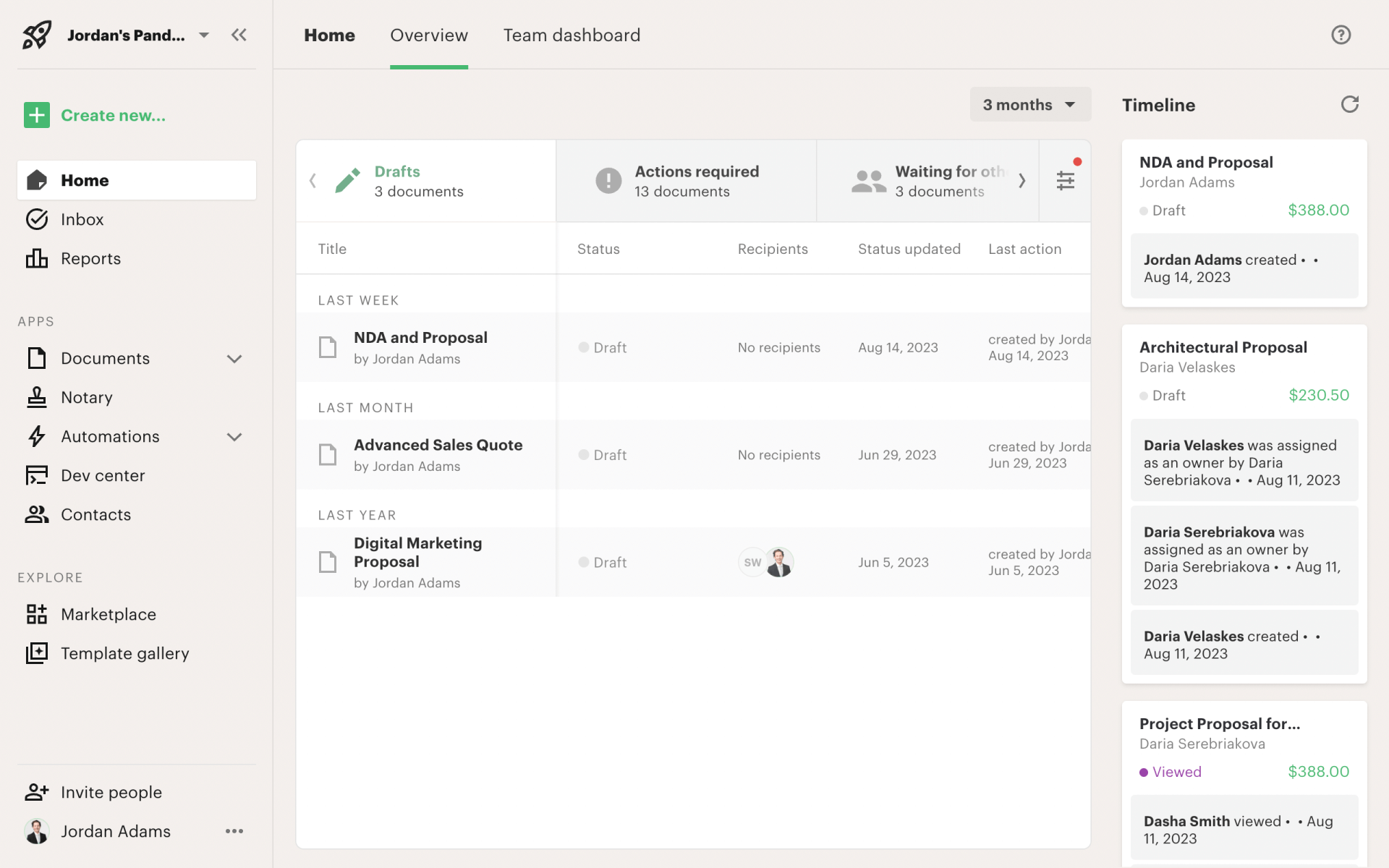
I have included PandaDoc to this list for its ability to handle a high volume of documents like proposals, contracts, and quotes. Its intuitive document editor allows users to create professional-looking documents with ease. The editor supports various content types, including text, images, tables, and videos, enabling users to create rich, engaging documents.
The platform also offers a variety of templates that users can customize to fit their specific needs, saving time and ensuring consistency across documents. The drag-and-drop functionality makes adding and rearranging elements easy, allowing users to focus on the content rather than the formatting.
What you will like:
- Supports legally binding electronic signatures, allowing users to send documents for signature directly from the application
- Provides detailed audit trails for each signed document, ensuring compliance and providing a clear record of the signing process
- The commenting system allows team members to leave notes and suggestions directly within the document, ensuring that all feedback is captured and addressed.
What you may not like:
- I felt that the look of the product seemed a little clunky and boxy— not sharp and modern
- Sometimes, it is difficult to get fillable fields aligned well within a document which results in final documentcould be morelook as profey could.
Pricing:
A free trial is available. Paid plan starts at $19/seat/month.
10. ClickUp – Best for Creating Richly Formatted Documents
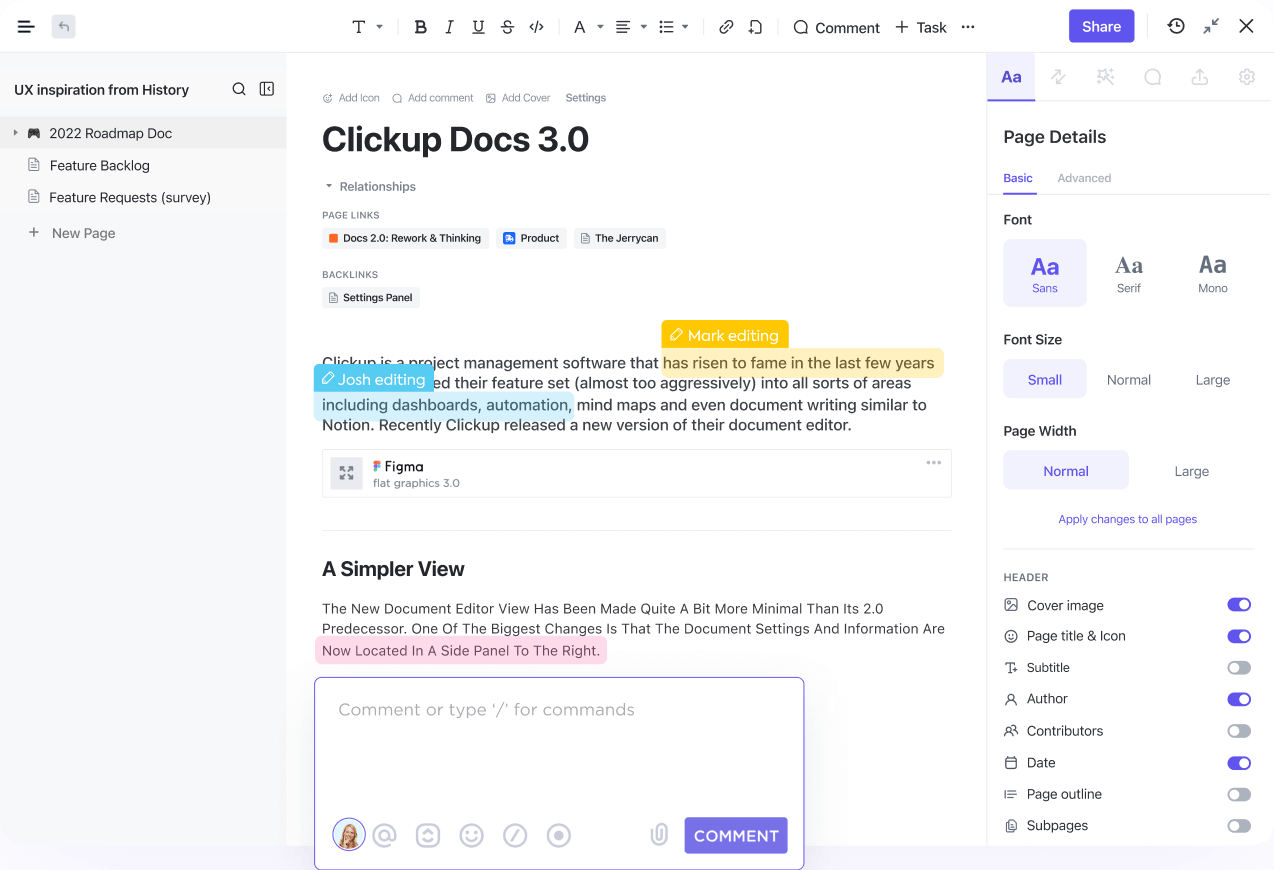
ClickUp helps teams create, collaborate on, and organize documents efficiently within the same workspace where they manage their projects and tasks. ClickUp Docs enhances team collaboration by integrating documentation with project management, ensuring all project-related information is easily accessible and up-to-date.
The platform allows users to create nested pages within documents, similar to a hierarchical folder structure, making organizing content by topic or project simple. It is especially beneficial for large projects that require extensive documentation, as it allows teams to break down information into manageable sections.
What you will like:
- Global search function, which enables users to find specific documents or information within their workspace quickly
- Lets users customize the appearance of their documents with various formatting options, including text styles, colors, and headers
- Supports rich media content, such as images, videos, and links, enabling users to create engaging and informative documents beyond plain text
What you may not like:
- I found the high volume of notifications overwhelming and sometimes difficult to manage effectively
- Inability to generate reports based on the notes that one has left.
Pricing:
Paid plan starts at $7/user/month.
Evaluation & Selection Criteria
The evaluation of products or tools chosen for this article follows an unbiased, systematic approach that ensures a fair, insightful, and well-rounded review. This method employs six key factors:
- User Reviews/Ratings: Direct user experiences, including ratings and feedback from reputable sites, provide a ground-level perspective. This feedback is critical in understanding overall satisfaction and potential problems.
- Essential Features & Functionality: The value of a product is ascertained by its core features and overall functionality. Through an in-depth exploration of these aspects, the practical usefulness and effectiveness of the tools are carefully evaluated.
- Ease of Use: The user-friendliness of a product or service is assessed, focusing on the design, interface, and navigation. This ensures a positive experience for users of all levels of expertise.
- Customer Support: The quality of customer support is examined, considering its efficiency and how well it supports users in different phases – setting up, addressing concerns, and resolving operational issues.
- Value for Money: Value for money is evaluated by comparing quality, performance, and features. The goal is to help the reader understand whether they are getting their money’s worth.
- Personal Experience/Expert’s Opinion or Favorites: This part of the evaluation criteria draws insightful observations from the writer’s personal experience and the opinions of industry experts.
Considering the varying requirements of creating documents, ProProfs Knowledge Base is the perfect balance between ease of use and a rich feature set. Its AI-enabled text editor comes with pre-built prompts and suggestions, making document creation a breeze. Multiple team members can collaborate easily on documents with internal comments.
I suggest going for a personalized demo before making your final decision. All the best!
Enhance Comprehensibilty With Extensive Technical Documents
The document creation software landscape is diverse and advanced, offering solutions catering to various needs and preferences. Whether you need to create technical documentation, manage contracts, or collaborate on project documents, there is a tool tailored to your requirements.
One tool that deserves your attention is ProProfs Knowledge Base. With its easy-to-use editor, rich media support, and robust search functionality, ProProfs Knowledge Base ensures that your documentation is comprehensive and easily accessible.
Its advanced analytics and reporting tools that provide insights into how your documentation is being used. These insights can help you improve your content and make it more useful for your audience.
FREE. All Features. FOREVER!
Try our Forever FREE account with all premium features!







